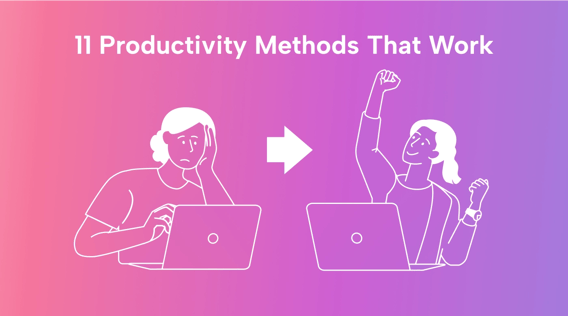We hate to say it, but willpower alone is rarely enough to unlock lasting productivity.
Even the hardest workers fall behind due to disorganized planning and poor time management.
If you’re running out of time every day, never seeing the end of your to-do list, and missing deadlines left, right, and center, you need a good productivity method in your life.
We’ve gathered the best 10 productivity methods to help you manage your time more effectively so you can achieve your goals faster.
Productivity methods for more effective planning
It’s hard to get started with your day when you don’t know what to work on first.
Having a go-to planning method (or two) to follow helps you organize your priorities so you can create an effective schedule that aligns with your goals.
Consider trying out one or more of the following:
1. Eisenhower Matrix
The Eisenhower Matrix, also called the priority matrix, organizes tasks into groups based on their urgency and importance.
Divide your tasks into the following four categories, and then handle each one according to its priority:
- Do: Important and urgent
- Schedule: Important but not urgent
- Delegate: Not important but urgent
- Delete: Unimportant and not urgent
Pros
- Dividing tasks into categories is quick and easy.
- It highlights distractions or tasks that could be omitted.
- Knowing what group of tasks to work on next is intuitive.
Cons
- Some tasks don’t fit neatly into one of the four categories.
- The method doesn’t consider task dependencies (e.g., a high-priority task that can only happen after you’ve completed a low-priority task).
- If too many tasks fall into one of the categories, there’s no system for prioritizing them further.
This productivity method works best if:
- You tend to spend too much time on unimportant tasks.
- You’re trying to schedule and organize several independent tasks.
- You’re not trying to plan a large, complex project with multiple task dependencies.
If the Eisenhower Matrix isn’t enough for your busy day, use a digital tool like Motion to simplify your planning. Motion automatically organizes tasks by their priority and deadline.
2. Personal Kanban
Personal Kanban is based on the Kanban project management technique. It involves grouping tasks by your progress and creating a Kanban flow to link the different categories.
The most common Personal Kanban technique involves organizing your tasks and projects into the following phases:
- To do
- Doing
- Done
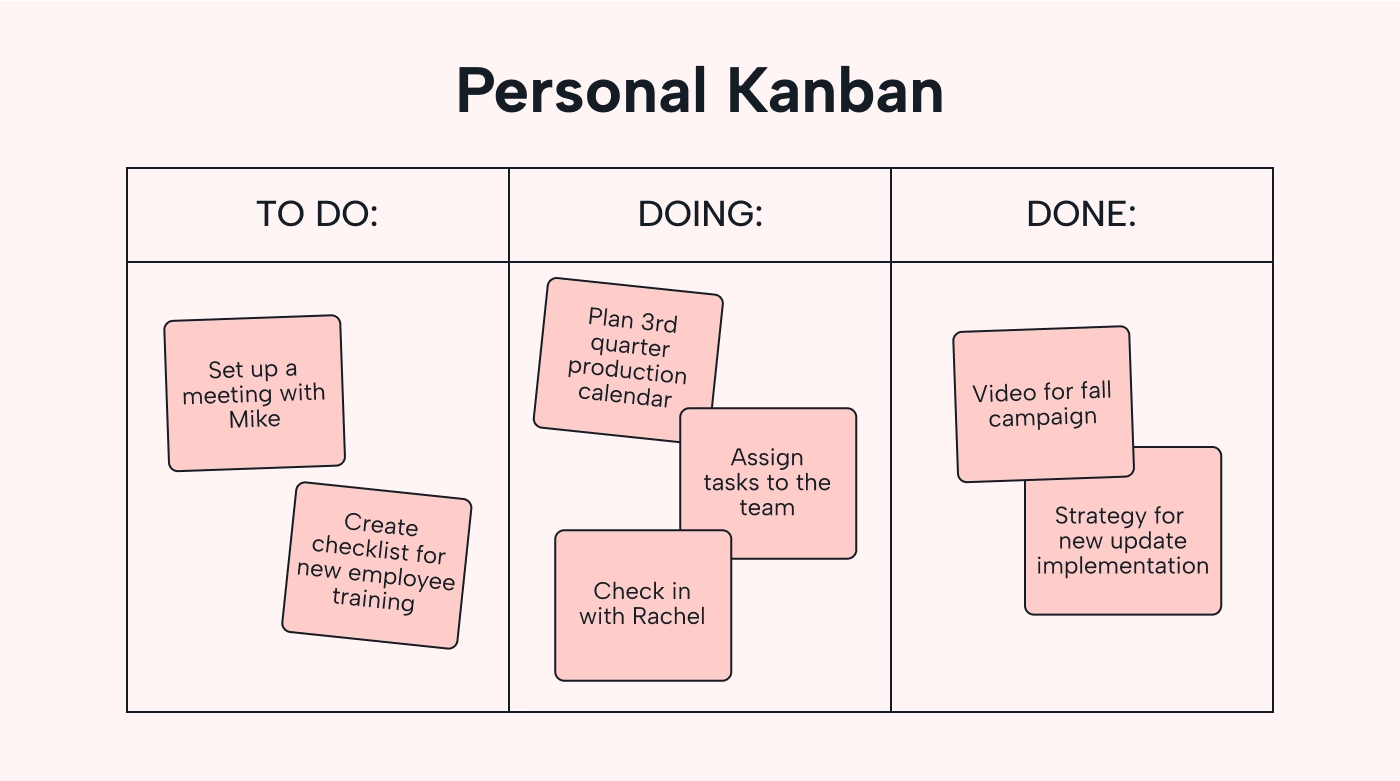 |
Pros
- Phases make the method easy to personalize.
- The board acts as a form of accountability by showing you what you’ve worked on but haven’t finished.
- The technique is easy to adapt to group settings.
Cons
- It can be inflexible (e.g., if you’re working on a dynamic project with many moving parts, figuring out which category each part belongs to can take up more time than it’s worth).
- It requires constant updating, which may distract you from actually working.
This productivity method works best if:
- You have a structured and predictable project with very few or no moving parts outside of the progress you make.
- You start projects eagerly but struggle to finish them.
3. Must, Should, Want
The Must, Should, Want method helps you divide tasks by their urgency by determining what can wait and what needs to be done today. It divides your to-do list into the following categories, which you’ll work on in this order:
- Must: Non-negotiable tasks and anything time-sensitive
- Should: Tasks that you need to do but aren’t time-sensitive
- Want: Tasks that would be nice to do but aren’t the most practical or necessary and can be put off without huge consequences
Pros
- It helps you focus on urgent and important tasks.
- It takes your preferences into account, helping to keep you motivated.
Cons
- The technique can put off your “wants” indefinitely, reducing your satisfaction and motivation.
- It can be difficult to organize broad tasks into one of the three specific categories.
This productivity method works best if:
- You tend to avoid working on your most important tasks and instead focus your energy on less important and impactful activities.
- You naturally carve out time for personal growth, work tasks you enjoy, or anything else that falls into the “want” category.
Productivity methods for more effective time management
You can plan and schedule all you like, but unless you sit down and work on your tasks, you won’t get any closer to achieving your goals.
If you get distracted easily and want to better manage your time, try the following time management productivity methods:
4. Pomodoro Technique
The Pomodoro Technique divides your workday into sprints and short breaks, prioritizing deep focus and frequent breaks to let you stretch your legs and give your eyes a rest from your computer screen.
To use the Pomodoro Technique, set a timer (or use this free Pomodoro timer) for 25 minutes to focus entirely on a single task. Every time the 25 minutes are up, take a five-minute break.
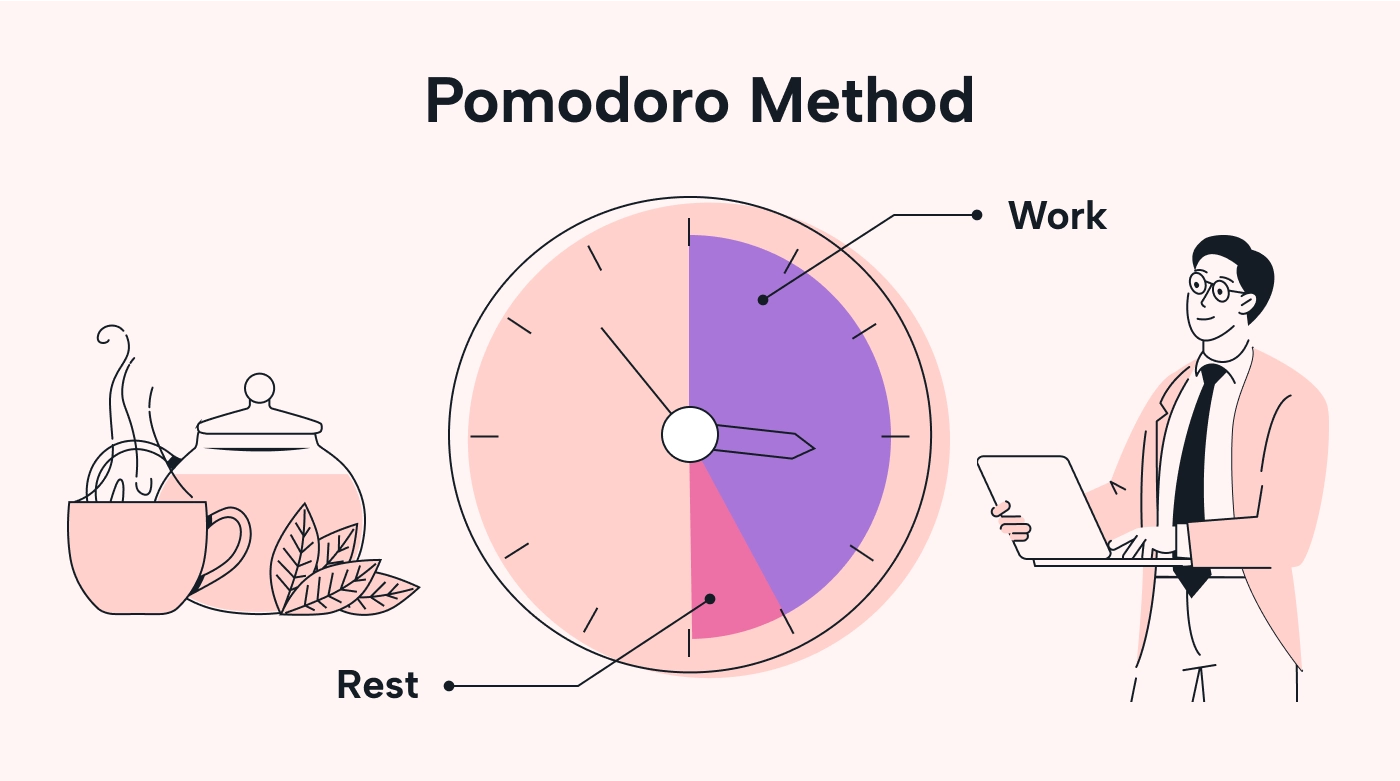 |
After repeating this cycle three times, take a longer break.
Pros
- It reduces burnout by prioritizing breaks.
- Shorter periods of deep focus help you avoid distractions (e.g., “10 minutes until my sprint ends — that email can wait”).
- You can determine how many cycles to spend on each task (the technique holds you accountable).
Cons
- It takes discipline and honesty (daydreaming for 25 minutes isn’t productive!).
- Interruptions are inevitable and make it difficult to stick to your sprints.
This productivity method works best if:
- Your concentration is often derailed by small, unimportant tasks.
- You feel like you don’t have enough time in the day to get to everything you need to do.
5. Time blocking
Time blocking divides your day into time blocks or time boxes. During each block, you’ll work on one task (monotasking) or a group of similar tasks (task batching) and ignore unrelated work.
Set aside chunks of time to focus on your task or task batch, and don’t allow yourself to work on anything else until each block is complete.
Pros
- It can help you uphold boundaries around your work time because you can mark yourself as “unavailable” during your dedicated time blocks.
- It can assist you in managing your personal and work tasks.
- It removes the temptation to multitask (which decreases productivity).
Cons
- It doesn’t account for necessary interruptions.
- It requires accurate time budgeting so you don’t under or overbook time.
- If your plans get derailed, it takes a lot of effort to reschedule the rest of your blocks (unless you use an AI-powered task manager like Motion!).
This productivity method works best if:
- You’re easily distracted or sidetracked by small interruptions.
- You’re prone to multitasking but rarely get through everything on your to-do list.
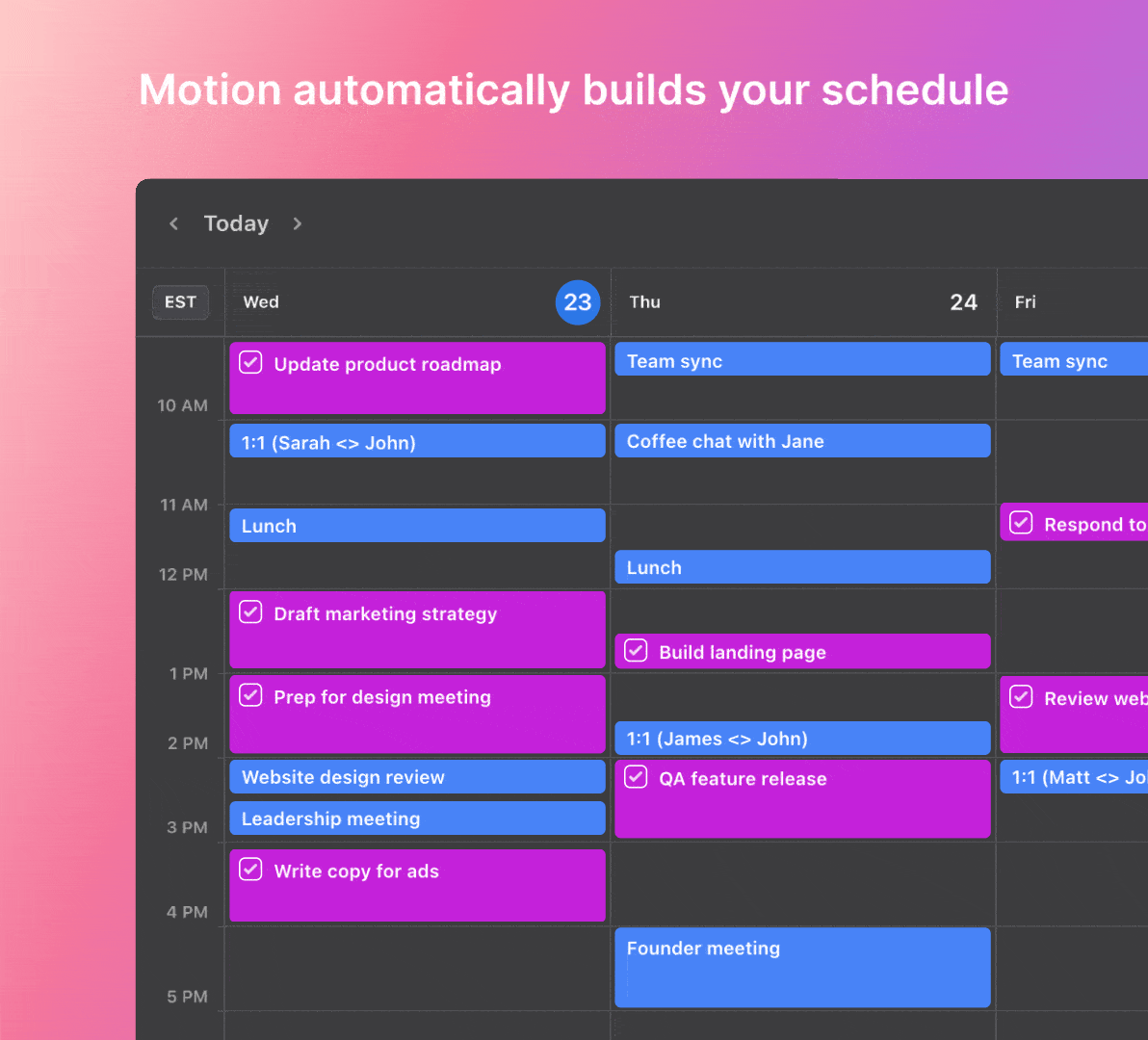 |
6. To-done and to-don’t lists
A to-done list contains a list of tasks or achievements you finished in a day. A to-don’t list contains a list of tasks or behaviors that you don’t want to do throughout the day.
By tracking your achievements, the to-done list gives you an “effort receipt” at the end of every day, helping you stay motivated. The to-don’t list holds you accountable by reminding you of the distractions you want to avoid.
Pros
- They’re simple to use and don’t require much planning ahead of time.
- The “effort receipt” you build every day helps you stay motivated by tracking and recording your achievements rather than just crossing them off and moving on.
Cons
- While both lists can help you stay focused and motivated, they won’t help you complete your tasks or manage your time more efficiently.
This productivity method works best if:
- You feel demotivated at the end of every workday because you have a long list of tasks you’ll need to work on the next day.
- You procrastinate in the same predictable way every workday.
7. Eat the Frog
Eating the Frog helps you build momentum. You work on your most difficult or daunting task at the beginning of the day. Then, you work on the smaller tasks.
By getting your toughest tasks out of your way first thing, you’ll feel more motivated to get through the rest of your work.
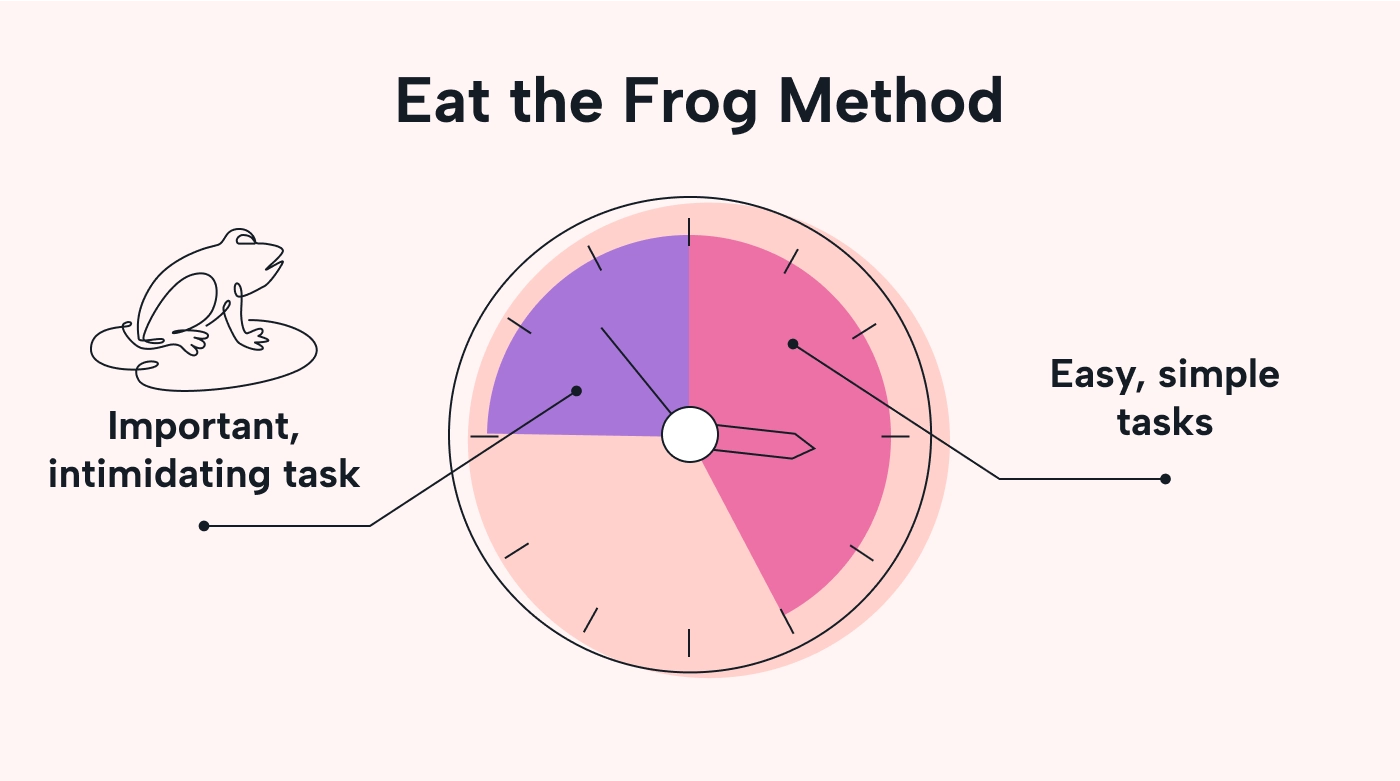 |
Pros
- It decreases your daily mental load because you don’t have to choose what to work on at the start of every day.
- It creates a motivating feeling of accomplishment because you’ve already done the most difficult task on your list.
Cons
- It doesn’t tell you how to manage your time after you’ve completed the initial task.
This productivity method works best if:
- You have a complex task or project that’s overwhelming you.
- You tend to procrastinate by working on smaller tasks and never get around to completing the most important ones.
Productivity methods for building better habits
Even small steps in the right direction are important. Building good habits gives you the chance to practice your consistency, effort, and diligence as you work toward becoming your most productive self.
If you want to build productive habits, try the following habit-building productivity methods:
8. Agile Results
The Agile Results method aims to align your daily to-dos with your big dreams. It’s a simplified, personalized version of the Agile Methodology used for project management.
For every long-term goal, identify three outcomes you want to see in the next year, month, week, and day. Each set should build toward the next to ensure you’re on the path to achieving your long-term goal every day.
At the end of each time period, review your progress and adjust as needed.
Pros
- It breaks intimidating goals into bite-sized chunks.
- It builds habits that move you closer to your goal.
- It allows for reflection and adjustments.
Cons
- It can be difficult to identify the “small chunks” necessary to move toward the bigger goal.
- Balancing multiple long-term goals can be overwhelming.
This productivity method works best if:
- You have one or two long-term goals that you want to work toward daily.
- You’re good at seeing the big picture and understanding what steps need to be taken to get there.
9. Don’t Break the Chain
The Don’t Break the Chain method helps you build a habit of working toward a long-term goal by prioritizing consistency and diligence over the quantity of work you do every day.
On each day that you do a task that builds toward your long-term goal, you mark that day off on a calendar. Consecutive days form a “chain,” which you can keep unbroken by consistently working toward your goal.
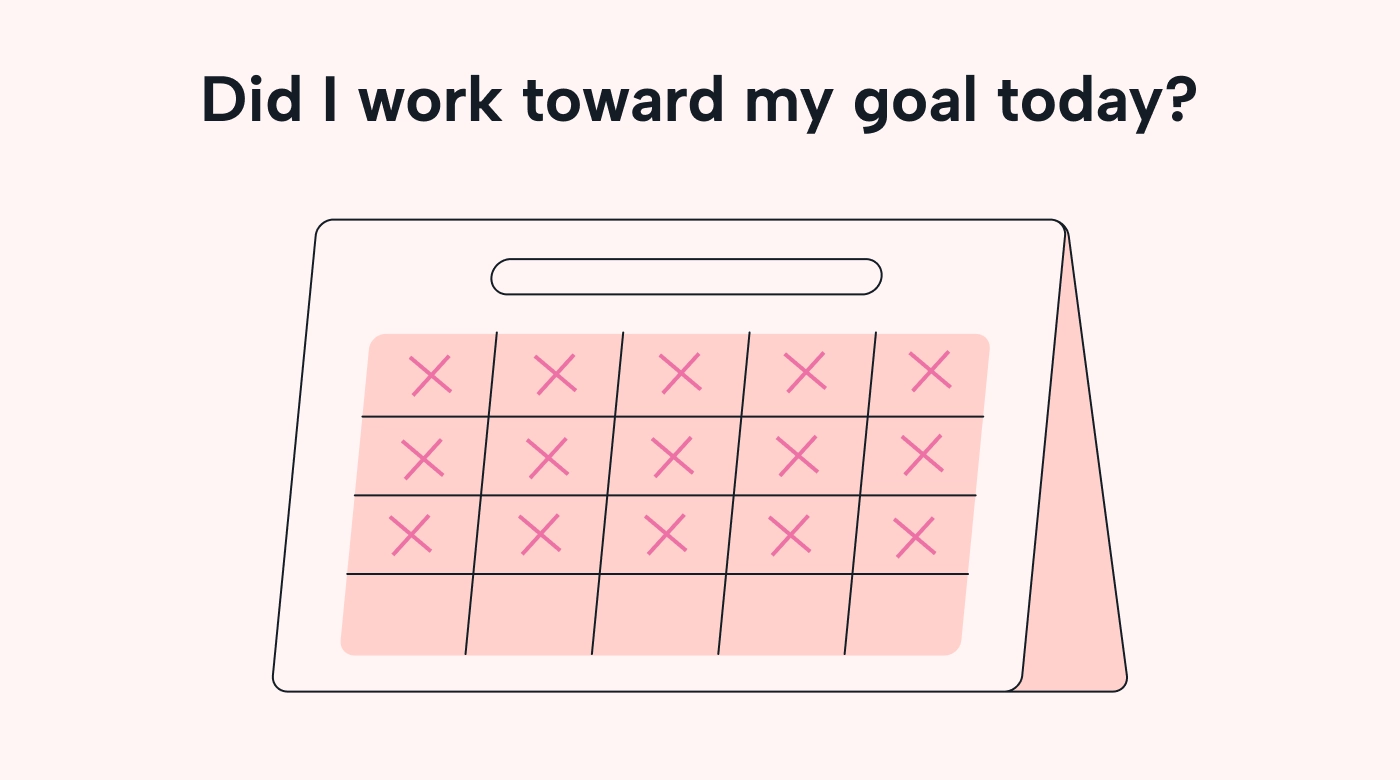 |
Pros
- It rewards consistency over the quantity of work you do, which helps to build a productive habit.
- Daily tasks can be small (e.g., if your goal is to write a book, writing one sentence counts toward your goal).
- The growing visual representation of progress is motivating.
Cons
- It isn’t inherently deadline-aware.
- It has zero grace for missing a day due to emergencies or urgent tasks.
- Breaking the chain can be incredibly disheartening.
This productivity method works best if:
- You aren’t working toward a deadline.
- You want to build a productive habit.
- You enjoy using visual aids.
10. Habit stacking
Habit stacking takes your existing habits and builds on them with other, more productive actions or tasks. The theory is that it’s easier to modify an existing habit than to build a new one from scratch.
To habit stack, identify a habit you have or a behavior you exhibit daily, as well as a behavior or action you’d like to do every day. “Stack” the second action onto your existing habit by performing it immediately after the habit action.
Pros
- Once the habit is built, it’s easy to keep it going.
- You can adopt multiple new habits at once.
Cons
- It can take a while to build associations between tasks.
This productivity method works best if:
- You have a habit that you do once or several times a day already, like taking a yoga break or reading a chapter in a book.
- You have a task that needs to be done as frequently as the habit you’ve associated it with.
Make productivity effortless with Motion
Whether you start using one or several of these productivity methods, you’re sure to build working momentum that grows stronger with every check on your to-do list.
If you want to give yourself a boost, why not let Motion plan your schedule for you?
Motion unlocks maximum productivity (with minimal effort) through the power of AI. Its calendar automatically schedules your tasks and events according to hard and soft deadlines, priority levels, and more.
Ready to experience the magic of effortless planning? Try Motion for free today.

For the last 12 years, Kimberly has been honing her craft across QA, programming, project management, and managerial leadership within IT. These days, she channels her expertise into writing at the intersection of tech, project management, and business.
